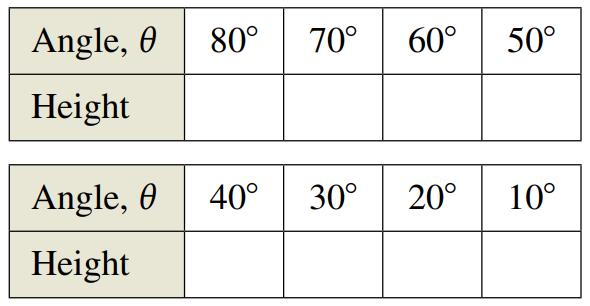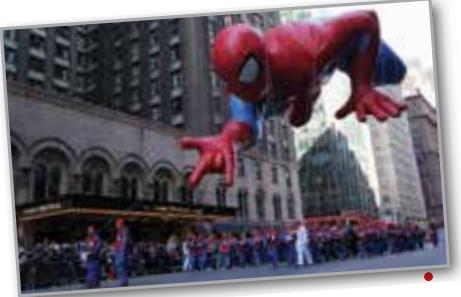
Concept explainers
A
(a) Draw a right
(b) Use a trigonometric
(c) The breeze becomes stronger and the angle the line makes with the ground decreases. How does this affect the triangle you drew in part
(d) Complete the table, which shows the heights (in meters) of the balloon for decreasing angle measures

(e) As

Want to see the full answer?
Check out a sample textbook solution
Chapter 1 Solutions
Trigonometry (MindTap Course List)
- Actividades: malemática (Erigonometria) Razones trigonometrica 2025 23 Jures Encuentra las seis razones of trigonométricas, on los siguienter tiringher rectangulies 4 A C =7 b=8cm. * c C=82m a=? * C * B A 4A=- 4 B= C=12cm B 9=7 C A b=6um B a=6cm Sen&c=- AnxB=- Sen&A = Anx = - Bos *A= - cos &c= Zang KA= Tong&c= ctg & A= — ctg &c= Séc & A = - Cosc&A= Secxce csck(= cos & C = - cos & B= Tong & C = — tang & B = d=g&c= cfg &c=— cg & B= sec &C= secxB=- оскв=- =_csCKB = 6=5m AnxA = - AnxB= cos * A= - cos &b= Tmg & A = - Tong & B=- ct₁ A = - C√ B=- cfg & Soc *A= Sec & B=- ACA=- CAC & B=- FORMATarrow_forwardClint is building a wooden swing set for his children. Each supporting end of the swing set is to be an A-frame constructed with two 10 foot long 4-by-4s joined at a 45 degree angle. To prevent the swing set form tipping over, Clint wants to secure the base of each A-frame to concrete footings. How far apart should the footings for each A-frame be?arrow_forwardFind the lengths of r, s, t, and u shown in the figure below if r+s=34. Round your answers to the nearest tenth. Note that the figure is not drawn to scale. 16 37° r = S u = t S u 24 ☑arrow_forward
- Find the lengths of w, x, y, and z shown in the figure below if xy=69. Round your answers to the nearest tenth. Note that the figure is not drawn to scale. w= x= z= 16 37° W 24 Х Zarrow_forwardQ3: Define the linear functional J: H(2) R by 1(v) = a(v. v) - L(v) Let u be the unique weak solution to a(u,v) = L(v) in H() and suppose that a(...) is a symmetric bilinear form on H(2) prove that 1- u is minimizer. 2- u is unique. 3- The minimizer J(u,) can be rewritten under algebraic form u Au-ub. J(u)=u'Au- Where A. b are repictively the stiffence matrix and the load vectorarrow_forward= 1 2 = 3 4 ווי LQ 5 Español On the unit circle, sketch 0 = 0.95π radians in standard position. Then use the coordinates shown, which are rounded to the hundredths place, to find cos (0.95π) and sin (0.95π). Write your answers to the hundredths place. (1.00, 0.00) 0.00 Drag to show the angle. 스 cos (0.95π) = ☐ sin (0.95π) = ☐arrow_forward
- From the ground, a rubber ball is launched 20 feet into the air. If its rebound is 7/10, how far will it have vertically traveled after the first five bounces?arrow_forwardS SC0004 Chrome File 0- -o Edit View History Bookmarks Profiles Tab Window Help www-awu.aleks.com/alekscgi/x/Isl.exe/1o_u-IgNsIkas NW8D8A9... Quiz 2 Unit Circle Question 3 of 5 (1 point) | Question Attempt: 1 of 1 1 2 3 4 = 5 Answer the following. (a) For each function below, indicate whether it is odd, even, or neither. f(x) = secx Odd Even Neither g(x) = cosx Odd Even Neither Απ (b) sec (Choose one) 11 (c) cos(-59°) = (Choose one) Continue O 202 ☑ G LT + Time Remaining: 17:04 Taylen Español Submit Assignment © 2025 McGraw Hill LLC. All Rights Reserved. Terms of Use | Privacy Center | Accessibility only Horo 324 1 JAN O O O 14 άtvarrow_forwardS Chrome File Edit View History Bookmarks Profiles Tab Window Help 0- -o www-awu.aleks.com/alekscgi/x/Isl.exe/1o_u-IgNsIkasNW8D8A9... Quiz 2 Unit Circle LT + Time Remaining: 22:04 Taylen Question 5 of 5 (1 point) | Question Attempt: 1 of 1 1 2 3 4 5 LO Español Suppose that is an angle in standard position whose terminal side intersects the unit circle at Find the exact values of cote, cose, and csc 0. 12 5 (몸-음) 13 13 SC0004 cote cose = ☐ = csc0 = II ☐ ☐ 202 O|O ☑ Submit Assignment © 2025 McGraw Hill LLC. All Rights Reserved. Terms of Use | Privacy Center | Accessibility only Horo 324 1 JAN O O O 14 άtvarrow_forward
- plete the parts below. ) Two unit circles are shown. Sketch the requested angles in standard position. Sketch the angle 11π 6 11π radians. Sketch the angle radians. 6 Español (1, 0) (1, 0) Drag to show the angle. Drag to show the angle. 스 Х ) Find the following. Use exact values and not decimal approximations. 11π sin ☐ 6 Continue SC0004 O 스 Х G Submit Assignment © 2025 McGraw Hill LLC. All Rights Reserved. Terms of Use | Privacy Center | Accessibility Silve Sobole 324 JAN O O O 14 ŕtvarrow_forwardLet θ = - 11π/4Part A: What is a coterminal angle of θ such that 0 ≤ θ ≤ 2π?Part B: What are the exact values of all six trigonometric functions evaluated at θ?arrow_forwardTriangle ΔABC has side lengths of a = 15, b equals 15 times square root of 3 and c = 30 inches. Part A: Determine the measure of angle m∠B. Part B: Show how to use the unit circle to find tan B. Part C: Calculate the area of ΔABC.arrow_forward
 Trigonometry (MindTap Course List)TrigonometryISBN:9781337278461Author:Ron LarsonPublisher:Cengage LearningAlgebra & Trigonometry with Analytic GeometryAlgebraISBN:9781133382119Author:SwokowskiPublisher:Cengage
Trigonometry (MindTap Course List)TrigonometryISBN:9781337278461Author:Ron LarsonPublisher:Cengage LearningAlgebra & Trigonometry with Analytic GeometryAlgebraISBN:9781133382119Author:SwokowskiPublisher:Cengage Trigonometry (MindTap Course List)TrigonometryISBN:9781305652224Author:Charles P. McKeague, Mark D. TurnerPublisher:Cengage Learning
Trigonometry (MindTap Course List)TrigonometryISBN:9781305652224Author:Charles P. McKeague, Mark D. TurnerPublisher:Cengage Learning Holt Mcdougal Larson Pre-algebra: Student Edition...AlgebraISBN:9780547587776Author:HOLT MCDOUGALPublisher:HOLT MCDOUGAL
Holt Mcdougal Larson Pre-algebra: Student Edition...AlgebraISBN:9780547587776Author:HOLT MCDOUGALPublisher:HOLT MCDOUGAL Mathematics For Machine TechnologyAdvanced MathISBN:9781337798310Author:Peterson, John.Publisher:Cengage Learning,
Mathematics For Machine TechnologyAdvanced MathISBN:9781337798310Author:Peterson, John.Publisher:Cengage Learning,




